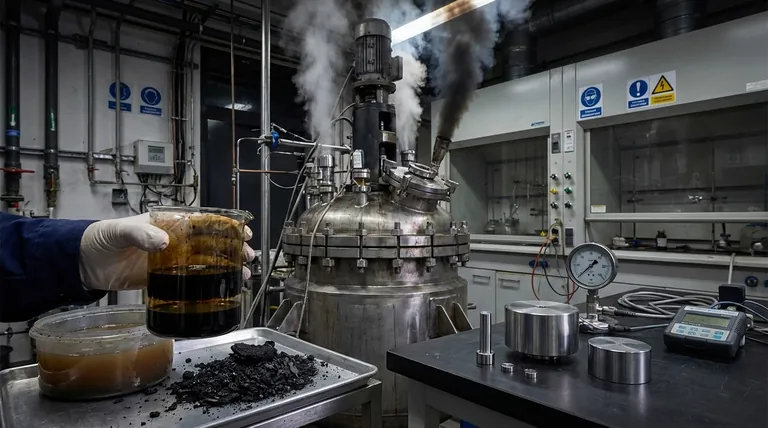While promising in theory, plastic pyrolysis is not a simple solution and faces significant practical and environmental challenges. The process can generate harmful air emissions, produces an unstable and difficult-to-use oil, and creates additional waste streams like char and contaminated water that require careful management.
The core problem with plastic pyrolysis is that it is not a clean, closed-loop recycling method. Instead, it is a complex chemical decomposition process that transforms plastic waste into a new set of challenging materials, each with its own environmental and handling issues.

The Challenge of Unstable End-Products
The primary output of plastic pyrolysis, pyrolysis oil, is often cited as its main benefit. However, the nature of this oil presents significant practical hurdles.
The Inherent Instability of Pyrolysis Oil
Pyrolysis oil is not a finished, stable fuel like diesel. It is a mixture of reactive, intermediate compounds left over from the decomposition of plastic.
Over time, these compounds continue to react with each other. This causes a gradual increase in the oil's viscosity (thickness) and can lead to phase separation, where the oil separates into distinct, unusable layers.
Issues with Thermal Degradation
Attempting to use or refine this oil often requires heating it. Heating the oil above 100°C can accelerate these unwanted reactions.
This process produces a thick, solid residue and releases volatile organic compounds (VOCs), which are a form of air pollution. This makes the oil difficult to use as a direct fuel source without extensive, and costly, pre-treatment.
Environmental and Operational Hurdles
Beyond the issues with its primary product, the pyrolysis process itself has notable environmental drawbacks that must be addressed.
The Risk of Harmful Air Emissions
The high-temperature, low-oxygen environment of a pyrolysis reactor can produce emissions that negatively impact air quality.
While proper furnace design, operation, and maintenance are critical to minimize these emissions, the risk remains. Preventing the release of hazardous pollutants requires sophisticated and well-maintained control technologies.
The Creation of Multiple Byproducts
Plastic pyrolysis does not make waste disappear; it transforms it. In addition to the oil, the process creates pyrolysis gas and a solid pyrolysis residue (char).
Furthermore, if the initial plastic waste has any moisture content, contaminated wastewater will be generated. Each of these byproducts must be safely managed, adding complexity and cost to the overall operation.
Understanding the Trade-offs
It is crucial to view pyrolysis not as a perfect solution but as a process with a specific set of compromises.
It Is Not True "Circular" Recycling
Unlike mechanical recycling, which can turn a plastic bottle back into a similar-grade plastic, pyrolysis is a form of chemical downcycling.
The outputs—unstable oil, gas, and char—are fundamentally different and often lower-value materials than the original plastic. Converting them into something useful, like a transportation fuel, requires significant and energy-intensive upgrading.
Feedstock Contamination is a Major Issue
The process is highly sensitive to the type and purity of the plastic waste used as feedstock.
Contaminants like food residue, labels, or different plastic types can disrupt the chemical reactions. This can lower the quality of the pyrolysis oil and increase the volume of hazardous waste in the solid char and wastewater byproducts.
Making the Right Choice for Your Goal
Evaluating plastic pyrolysis requires aligning its capabilities with your primary objective.
- If your primary focus is waste volume reduction: Pyrolysis can effectively reduce the sheer volume of plastic waste, but be prepared to manage the complex and potentially hazardous outputs.
- If your primary focus is creating a stable, high-value fuel: The process is a poor fit without a significant investment in sophisticated technology to upgrade and stabilize the volatile pyrolysis oil.
- If your primary focus is an environmentally benign solution: The risks of air emissions and the challenge of managing byproducts mean that waste reduction, reuse, and mechanical recycling are often superior approaches.
Ultimately, a clear-eyed assessment reveals that plastic pyrolysis transforms one complex waste problem into several others.
Summary Table:
| Challenge | Key Issue | Impact |
|---|---|---|
| Unstable Oil Output | Reactive compounds cause viscosity increase and phase separation | Difficult to use as fuel without costly treatment |
| Harmful Emissions | Risk of VOCs and air pollutants from thermal degradation | Requires advanced control technology to minimize |
| Byproduct Management | Creates char, gas, and contaminated wastewater | Adds complexity, cost, and environmental handling issues |
| Feedstock Sensitivity | Contaminants disrupt reactions and lower oil quality | Increases hazardous waste volume |
Need reliable solutions for your laboratory's material processing or waste management challenges? At KINTEK, we specialize in providing high-quality lab equipment and consumables tailored to your research and operational needs. Whether you're exploring alternative energy sources or managing complex chemical processes, our expertise ensures you have the right tools for accurate, safe, and efficient outcomes. Reach out to our team today to discover how KINTEK can support your laboratory's success!
Visual Guide

Related Products
- Anti-Cracking Press Mold for Lab Use
- Laboratory Test Sieves and Sieving Machines
- Laboratory Sterilizer Lab Autoclave Pulse Vacuum Lifting Sterilizer
- Laboratory Sterilizer Lab Autoclave Vertical Pressure Steam Sterilizer for Liquid Crystal Display Automatic Type
- HFCVD Machine System Equipment for Drawing Die Nano-Diamond Coating
People Also Ask
- What products use compression molding? Manufacture Large, Durable Components
- What is the compression method of processing plastic? A Guide to Strong, Cost-Effective Molding
- How to use a press mould? Master the Art of Consistent Ceramic Forms
- What is the manufacturing process of rubber molding? Injection, Compression, or Transfer Molding?
- How do you prepare a maintenance list for Mould maintenance? Implement a Proactive Tiered System



















